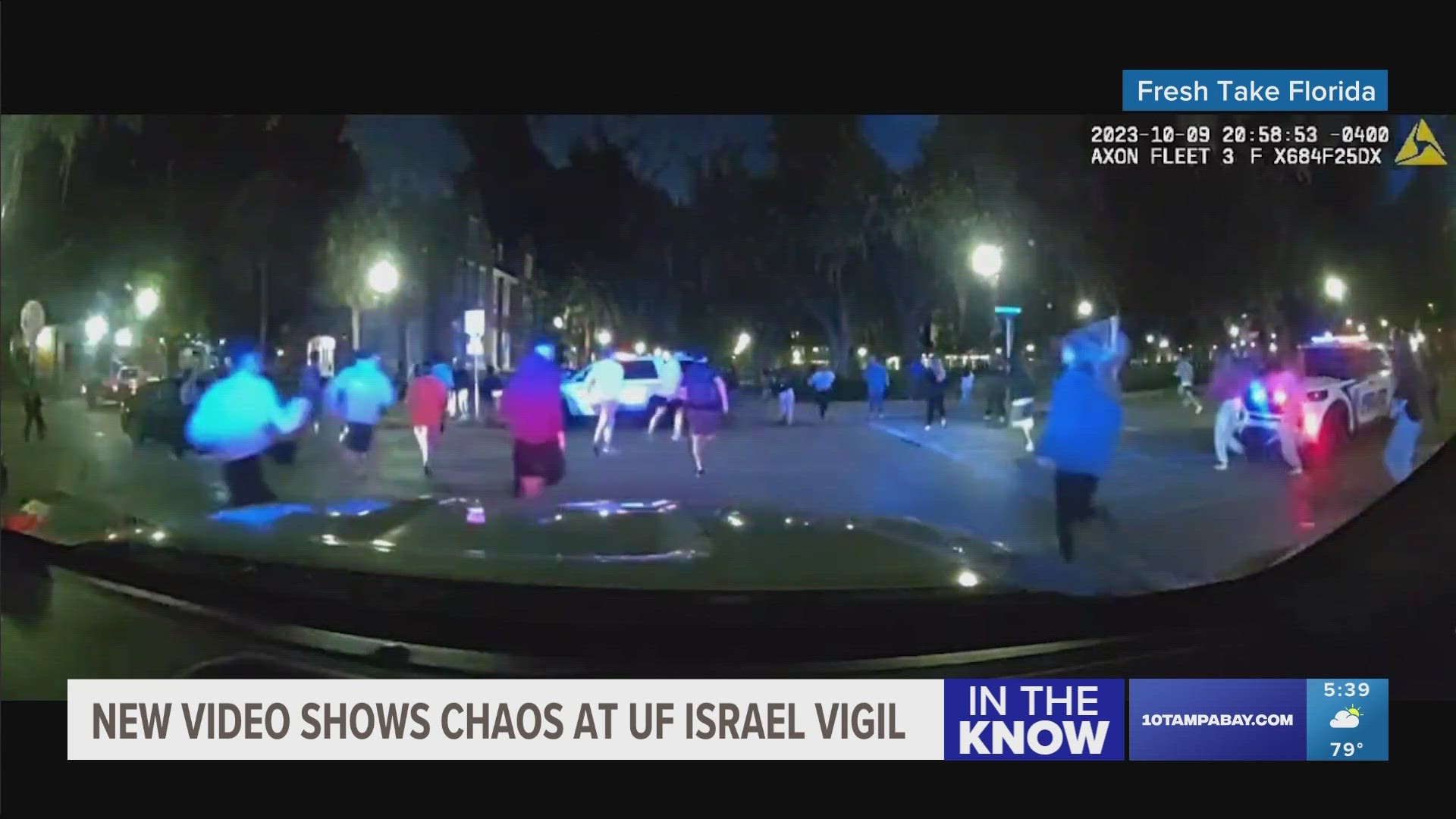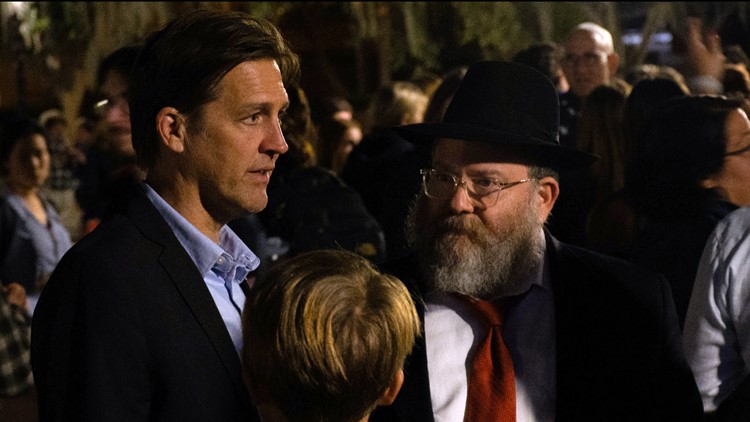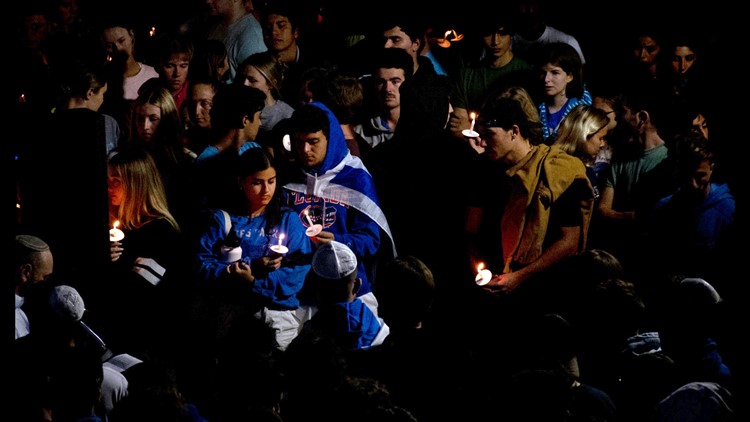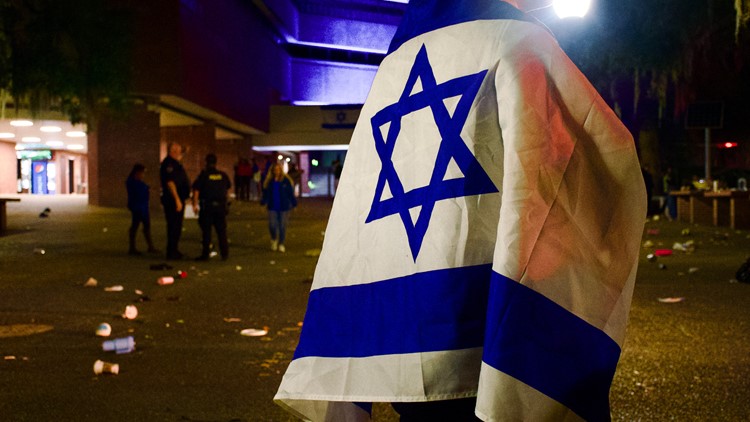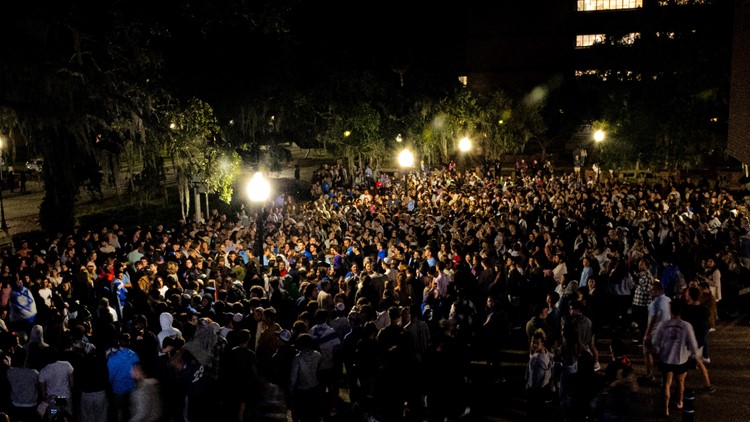GAINESVILLE, Fla. — Newly released body camera videos from a panicked stampede at the University of Florida during a nighttime vigil last month for Israelis killed by Hamas show waves of terrified students sprinting out of their shoes, discarding phones and water bottles and colliding with startled and confused police officers who had drawn their pistols searching for a possible gunman through the melee.
The videos show a human wave of hundreds of students running toward Sgt. Stephanie Williams, who was racing to respond with his pistol in his hand. Students were seen crashing into and bouncing off Williams over the next 19 seconds.
The videos also revealed that police earlier the same day were secretly investigating a threat to explode a suicide bomb inside a backpack last month. A neighbor told police she overheard an older man in this college town discuss his plan "to kill a bunch of Jews." Students said they were not warned about the threat, which has not previously been reported. When a reporter asked organizers about it, they expressed surprise and asked to see the evidence.
The university administration, through a spokeswoman, declined to say whether it had been informed about the threat that night or considered warning the more than 1,200 students and others at the vigil. UF's new president, Ben Sasse, was at the vigil.
University of Florida students hold vigil for Israelis killed in Hamas attacks
"I'm going to defer to the PD on how they explain that," spokeswoman Cynthia Roldan said. "There are many moving pieces."
The university’s police department, which did not answer written questions about the incident last week, said in a new statement Monday that the Gainesville Police Department didn’t warn it about the bomb threat until after the vigil had already started. Officers with the campus police department met privately among themselves at 7 p.m. on Oct. 9 to review its plans to protect students at the event and shut down some streets nearby.
“Prior to the event, a security plan was completed and there were no reported threats,” said the statement from Capt. Latrell Simmons. “After the event started, UPD learned of concerns that were shared by a member of the Gainesville community with GPD. UPD and GPD worked to ensure that there were no viable threats posed.”
In a new statement Monday, the FBI said it takes all such threats seriously. The FBI had not responded to messages about the investigation Friday last week or through the weekend.
“We will continue to share information and take action to identify and disrupt any potential threats that may emerge,” the FBI statement said. It urged the public to report anything they consider suspicious to local law enforcement or the FBI directly.
Fran Townsend, who served as the White House homeland security adviser under President George W. Bush, said the complex calculus of whether UF should have warned organizers or students more broadly depended on how convincingly police could have assured the university's president they could keep students safe from the bomb threat.
"You rarely have that level of certainty," Townsend said in an interview. "I hesitate to criticize the university administration, but it sounds like from what we do know, it would have been a better practice to have spoken to the Jewish student groups." She added: "People send their children to universities where safety and security is part of the university's job. I do think that has to inform the decision."
Townsend said police may have convinced UF administrators the would-be bomber during the vigil was "wrapped up," either in police custody or under physical or technical surveillance. She said during her years in the White House authorities weighed when to warn publicly about terrorist threats, to avoid unnecessarily canceling large-scale events, giving publicity to people who make threats or disrupting sensitive national security investigations.
At the scene of the stampede, which injured at least 30 students and made national headlines, police in the newly released videos said the FBI's regional joint terrorism task force was investigating the matter. A Gainesville police spokesman, Sgt. Joseph J. Castor, confirmed Friday the FBI was involved. The State Attorney’s Office said the matter was being handled by federal prosecutors with the U.S. Attorney’s Office for the Northern District of Florida.
This reporting by Fresh Take Florida, a news service operating out of the College of Journalism and Communications, is based on interviews, police reports and a review of more than eight hours of police videos obtained from that night.
Police later concluded that the students panicked because a woman in the crowd had fainted and her boyfriend shouted for others to call 911, not because of gunfire or an explosion. In the videos, police found the woman nearby lying on her back being tended by her boyfriend and others. In her first interview to emerge since the stampede, she said she donated blood weeks ago and was feeling weak before she blacked out: "I think it was me," she said. "I think I scared everybody."

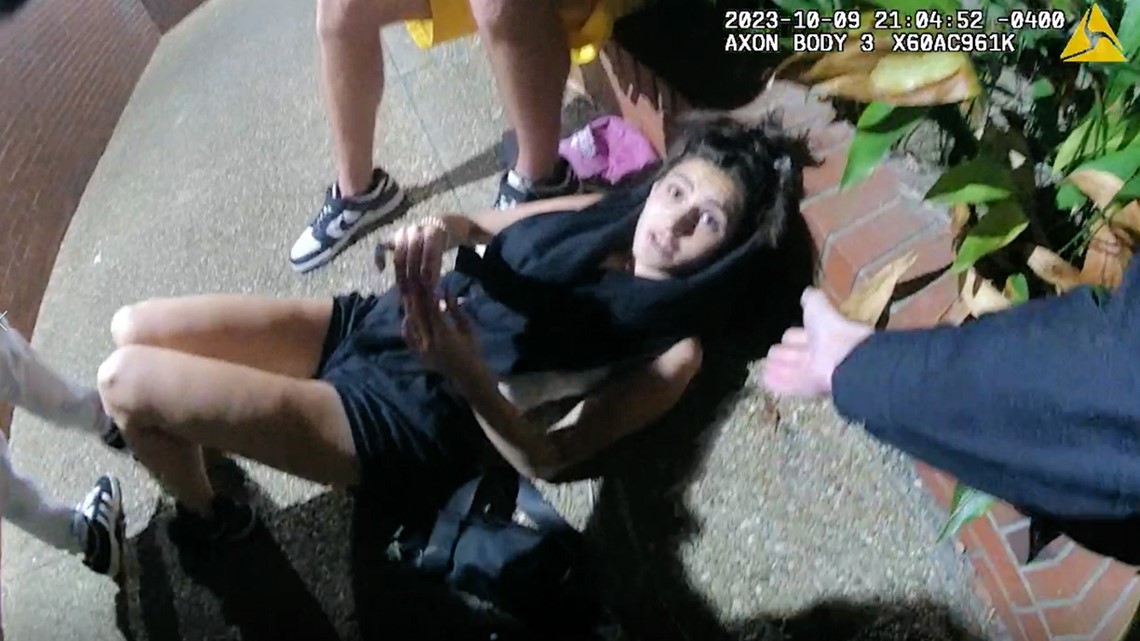
Twenty-four minutes after the stampede the night of Oct. 9, the campus police chief, Linda J. Stump-Kurnick, stood in the mostly emptied plaza receiving a private update from officers about the terror threat earlier in the day.
"About the call earlier, can you send it to me?" Stump-Kurnick asked Silver, who told the chief that police tracked the man accused of making the bomb threat to his apartment and used utility records to identify the account holder at that address. That led police to trace the man's vehicle and license plate number.
"That person needs to hurt," said Stump-Kurnick, then added a moment later: "with some jail time, if he did any of this."

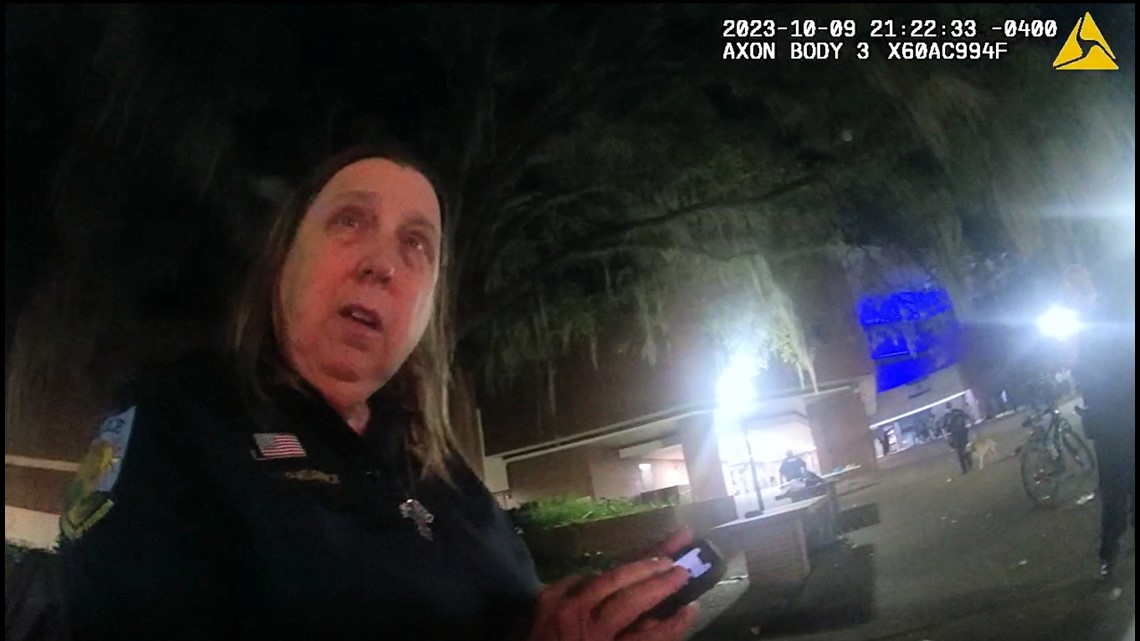
The new reporting uncovered that:
Two officers followed a blood trail through three floors of the Newell Hall classroom building nearby. “Blood, blood, blood, blood, blood. There is blood here,” Williams said to Officer Joshua Jablanski, pointing at the ground. They later found a woman with a head wound and injured shoulder hiding with others in a downstairs office and escorted her to an ambulance.
Just 11 minutes after the panic, police radios came alive with reports of "shots fired" near the UF School of Landscape Architecture and Planning, about 700 feet southeast of the plaza where the panic started. Officers rushed to that scene – some armed with assault rifles and others riding bicycles – and spent 10 minutes searching every room of the open-air building but found nothing unusual.
Around the plaza, police found distraught, trembling, tearful students – some bleeding or otherwise wounded – and sought to console them. "Be gentle," the police chief told officers. "They’re helping each other right now."
A team of sheriff's deputies with assault rifles and drawn pistols searched the nearby Turlington Hall classroom building – where some students were still studying – to be sure there was no hidden gunman. At times, the group appeared disoriented and lost inside the labyrinth of hallways, classrooms, restrooms, elevators, stairwells and exits. Video showed they consulted maps on the walls as they stalked through the building. "It's like a frickin' maze," officer J.D. Gentry, the UF officer who led the deputies, said, according to his body camera. "Stairs? Gosh, I don't know where all the stairs are in the building."
Police waited for a bomb squad to sweep backpacks and bags left behind on the outdoor plaza where the vigil took place – the apparent target of the suicide bombing threat earlier in the day – but it was taking too long. The university's own police dog, Beto, who had been on the scene since the start, needed rest to continue, police said. Impatient students wanted to collect their belongings. Discarded phones rang or pinged from owners trying to find them. "We can start letting people across the street," the chief decided.
The man accused of making the threat was not identified by name but described as in his 60s in the police videos, which were obtained under Florida’s public records law. He has not been arrested, according to a review of jail and state and federal court records.
Seventeen pages of police incident reports from that night, also obtained under the state’s records law, were heavily censored. The uncensored passages do not mention the bombing threat or FBI investigation.
It remained unclear whether police had briefly detained the man that day or watched him to be sure he didn't attempt to carry out the alleged threat.
Even before someone is formally arrested, charged or convicted of a crime, university police can ban individuals from UF's sprawling campus with official trespass orders. No such order has been issued to anyone fitting the bomb suspect's description since Oct. 9.
UF’s police department did not respond to written questions about the threat. An FBI spokeswoman in Jacksonville did not respond to messages Friday or through the weekend.
Police found the woman who had fainted – and who inadvertently set off the chaos – lying with her head propped against a brick landscaping wall around the corner. “This came on really fast,” she said. She was surrounded by her boyfriend and two women. "What happened was, she passed out, and I started yelling, 'Call 911,' and I think that's what caused everyone to run," the woman’s boyfriend said, exhaling a huge sigh. Police did not identify them.
___
This story was produced by Fresh Take Florida, a news service of the University of Florida College of Journalism and Communications. The reporter can be reached at loren.miranda@freshtakeflorida.com. You can donate to support our students here.

